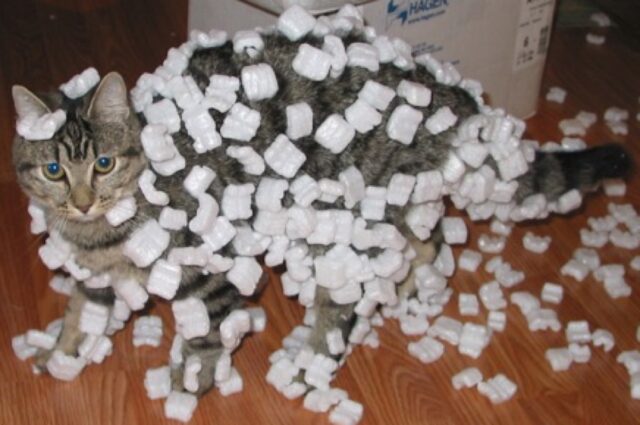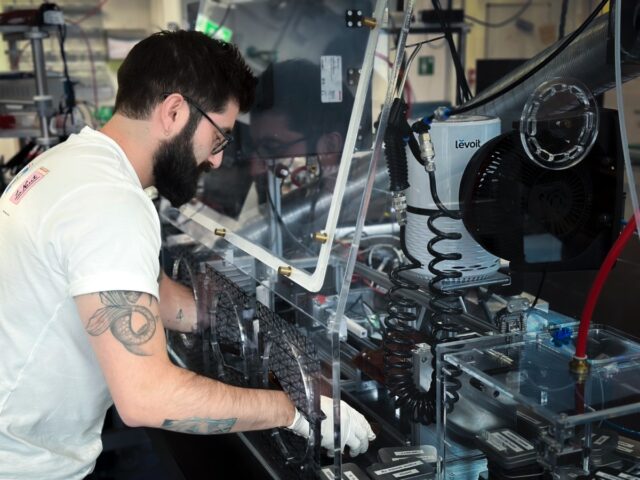Static electricity—specifically the triboelectric effect, aka contact electrification—is ubiquitous in our daily lives, found in such things as a balloon rubbed against one’s hair or styrofoam packing peanuts sticking to a cat’s fur (as well as human skin, glass tabletops, and just about anywhere you don’t want packing peanuts to be). The most basic physics is well understood, but long-standing mysteries remain, most notably how different materials exchange positive and negative charges—sometimes ordering themselves into a predictable series, but sometimes appearing completely random.
Now scientists at the Institute of Science and Technology Austria (ISTA) have identified a critical factor explaining that inherent unpredictability: It’s the contact history of given materials that controls how they exchange charges in contact electrification. They described their findings in a new paper published in the journal Nature.
Johan Carl Wilcke published the first so-called “triboelectric series” in 1757 to describe the tendency of different materials to self-order based on how they develop a positive or negative charge. A material toward the bottom of the list, like hair, will acquire a more negative charge when it comes into contact with a material near the top of the list, like a rubber balloon.
The issue with all these lists is that they are inconsistent and unpredictable—sometimes the same scientists don’t get the same ordering results twice when repeating experiments—largely because there are so many confounding factors that can come into play. “Understanding how insulating materials exchanged charge seemed like a total mess for a very long time,” said co-author Scott Waitukaitis of ISTA. “The experiments are wildly unpredictable and can sometimes seem completely random.”
A cellulose material’s charge sign, for instance, can depend on whether its curvature is concave or convex. Two materials can exchange charge from positive (A) to negative (B), but that exchange can reverse over time, with B being positive and A being negative. And then there are “triangles”: Sometimes one material (A) gains a positive charge when rubbed up against another material (B), but B will gain a positive charge when rubbed against a third material (C), and C, in turn, will gain positive charge when in contact with A. Even identical materials can sometimes exchange charge upon contact.

Gaining a more thorough understanding of triboelectricity matters because static charge occurs everywhere and can have serious consequences. For instance, pipes carrying combustible fuels like gas can accumulate significant charge along the walls even if those pipes are nonconducting. Pneumatic transport systems can catch fire if too much tribocharge builds up during use. In 2017, there was a chemical explosion at a Chinese plant that killed one person and injured several others—the result of a spark generated by merely wiping a rail near a chemical tank while that tank was being filled with a flammable chemical.
Aircraft and helicopter blades can build up triboelectric charge (called P-static) as a result of air friction. Spacecraft that build up enough triboelectric charge can cause interference with communication systems. Triboelectric charge can also cause issues with medical cable assemblies and the cables used in underwater acoustical transducers. Your car tires contain carbon black to help conduct away any tribocharge buildup. On the plus side, triboelectricity can be exploited in nanogenerators to convert mechanical energy into electricity.
Waitukaitis and colleagues decided to focus on triboelectric charge resulting from contact between identical materials, reasoning that this might reveal a clue to the enduring mystery. It also helped them reduce the number of potentially confounding variables. For their experiments, they decided to use plastic blocks made out of a clear silicon-based polymer called polydimethylsiloxane (PDMS) and measure how different samples exchanged charge under different conditions. They were particularly keen to learn whether identical samples would order into a triboelectric series.
Random results… or a hidden clue?

Co-author Juan Carlos Sobarzo, an ISTA graduate student, was initially frustrated when he got the same random and unpredictable results as so many others before him. His first samples—reused from earlier experiments—did indeed order into a triboelectric series, but repeating the experiment with fresh samples produced random results. Undeterred, Sobarzo kept repeating his experiments with the same set of samples, and on the fifth attempt, he once again achieved an ordered triboelectric series.
Repeated contact turned out to be the key, enabling the samples to evolve over time. “As soon as we started keeping track of the samples’ contact history, the randomness and chaos actually made perfect sense,” said Waitukaitis. Generally speaking, the team discovered that they could get predictable results from their samples after 200 repeated contacts. The sample with more contacts in its history consistently gained a negative charge in relation to the sample with a lower contact history. By controlling the number of contacts and the order of experiments, they could even form their own designer triboelectric series.
It’s still unclear how this repeated contact changes the samples, but subsequent experiments revealed that those repeated contacts smoothed out tiny bumps in the sample surfaces. It’s the only change they could detect, and it hints at two possible mechanisms: mechanochemistry and flexoelectricity. More research is needed to test both hypotheses.
“We conclude that the unpredictability in contact electrification may not be so hopeless after all,” the authors wrote. “By carefully paying attention to contact history, we can not only explain the unpredictability in our system, but even tame it.” In light of their findings, they added, “the notion of triboelectric series may be a useful heuristic but not much more. If the effect is widespread, chasing an immutable ordering is comparable to chasing a mirage.”
Nature, 2025. DOI: 10.1038/s41586-024-08530-6 (About DOIs).